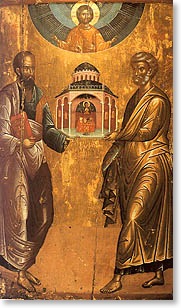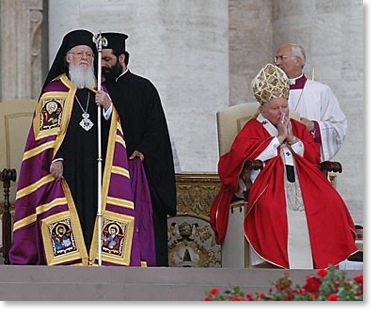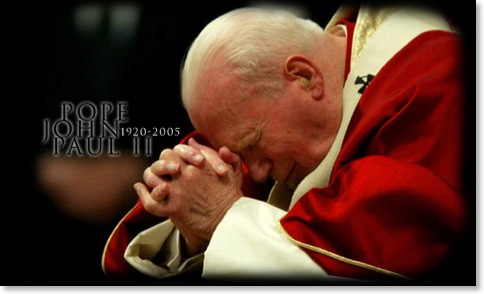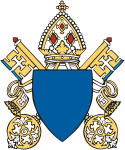
Catholic Prayer Revival
Apologetics on the Pope
Catholics invented the Pope to replace Christ. The Pope is not an invention, and he does not replace Christ. In Mt. 16:18-19, Jesus made it clear that he wanted Peter to lead his church on earth. Why? Jesus knew that he would die and that his Church needed a shepherd to guide it. Jesus does not tell Peter that he will replace him; He only states that Peter will be given authority and power to act in His name.
Let us look at what the early church taught: Early Christian Writings of St. Clement of Rome (Letter to the Corinthians 80 A.D. - Taken from the DIDACHE:
21 [44,1] Our Apostles knew through our Lord Jesus Christ that there would be strife for the office of bishop. [2] For this reason, therefore, having received perfect foreknowledge, they appointed those who have already been mentioned, and afterwards added the further provision that, if they should die, other approved men should succeed to their ministry. [3] As for these, then, who were appointed by them, or who were afterwards appointed by other illustrious men with the consent of the whole Church, and who have ministered to the flock of Christ without blame, humbly, peaceably and with dignity, and who have for many years received the commendations of all, we consider it unjust that they be removed from the ministry.
What proof do you have that Peter was the first Pope? The term "Pope" signifies the head Bishop of the Catholic Church. Catholics consider Peter the first Bishop of the Catholic Church. Let us look at Mt. 16:18-19:
(Mt. 16:18-19): And I say also unto Thee, that thou art Peter, and upon this rock I will build my church; and the gates of hell shall not prevail against it. And I will give unto thee the keys of the kingdom of heaven: and whatsoever thou shalt bind on earth shall be bound in heaven: and whatsoever thou shalt loosen earth shall be loosed in heaven.
It is interesting to note that in Mt. 16:18-19 Jesus quotes Isaiah 22:21-22:
(Isaiah 22:21-22) - And I will clothe him with thy robe, and strengthen him with thy girdle, and I will commit thy government into his hand and he shall be a father to the inhabitants of Jerusalem, and to the house of Judah. And the key of the house of David will I lay upon his shoulder; so he shall open, and none shall shut; and he shall shut and none shall open.
What does this quote mean? Jesus is referencing Isaiah in order to show that authority is being passed down not only in the Old Testament but also in Jesus' words "thou art Peter, and upon this rock I will build my church." It is a clear indication of apostolic succession. Jesus will "build" his church but it will not be finished being built. There will be those who will follow.
Let us look at Revelation 1:18 and what "keys" signify.
(Rev. 1:18): I am he that liveth, and was dead; and behold, I am alive for evermore. Amen; and have the keys of hell and of death.
Who holds the keys in Revelation? God! Just as Jesus gave the apostles the power to cast out demon's in his name. By Jesus giving Peter the keys to the kingdom of heaven, he is giving him the power to do as he did while he was on earth, such as forgiving sins, making decisions about the church and the faith. Jesus continues by saying, "whatsoever thou shalt bind on earth shall be bound in heaven: and whatsoever thou shalt loosen earth shall be loosed in heaven." Jesus is telling Peter as ruler of the church on earth his decisions on earth will be also recognized in heaven. Let us look also at John 21:15-17, Jesus singles out Peter as tell him 3 times to feed his sheep:
(John 21:15-17): So when they had dined, Jesus saith to Simon Peter, Simon, son of Jonas, lovest thou me more than these? He saith unto him, Yea, Lord, thou knowest that I love thee. He saith unto him, Feed my lambs. He saith to him again the second time, Simon, son of Jonas, lovest thou Me? He saith unto him Feed my sheep. He saith unto him the third time, Simon, son of Jonas, lovest thou me? Peter was grieved because he said unto him the third time. Lovest thou me? And he said unto him, Lord, thou knowest all things; thou knowest that I love thee. Jesus saith unto him, Feed my sheep.
What is Jesus trying to tell Peter when He states, feed MY sheep? MY sheep, are what? They are Jesus' followers. Jesus as head shepherd asks Peter to carry on as the head shepherd of the flock. How will Peter feed the flock? Peter will feed the flock spiritually. Here are some additional verses that confirm Peter's role as head of the church.

(Lk 22:32) - Jesus: But I have prayed for thee (Peter) that thy faith fail not; and when thou art converted, strengthen thy brethren.
(Acts 1:15) - And in those days Peter stood up in the midst of the disciples, and said…
(Acts 2:14) And Peter, standing up with the eleven, lifted up his voice, and said unto them, Ye men of Judaea, and all ye that dwell at Jerusalem, be this known unto you, and hearken to my words:
(Acts 4:8-12) - Then Peter, filled with the Holy Ghost, said unto them, Ye rulers of the people, and elders of Israel…
(Acts 15:7) - And when there had been much disputing, Peter rose up, and said unto them, Men and brethren, ye know how that a good while ago God made choice among us, that the Gentiles by my mouth should hear the word of the gospel, and believe.
The Pope makes up rules that Catholics must follow blindly. The Catholic Almanac states the following:
"The Roman Pontiff---the successor of St. Peter as the Bishop of Rome and head of the Church on earth-has full and supreme authority over the universal Church in matters pertaining to faith and morals (teaching authority), discipline and government (jurisdictional authority). The Pope's authority is on issues concerning faith and morals."
What this means is that Catholics do not follow rules that the Pope makes up. The Pope's words are only binding on the Catholic people when he speaks ex cathedra (from the chair of Peter) making an infallible statement. According to the Catholic Almanac this occurs very rarely. When the Pope is speaking authoritatively or ex cathedra, he is not alone. As Jesus promised, the Holy Spirit will guide the Pope on his decisions and the Pope also consult as well with the bishops of the church. What power do the bishops have? I will quote from the book Jesus, Peter & the Keys (S. Butler, N. Dahlgren, Rev. Hess)
'"The power which they [the bishops] exercise personally in the name of Christ, is proper, ordinary and immediate, although its exercise is ultimately controlled by the supreme authority of the Church [Lumen Gentium 27]'" But the bishops should not be thought of as vicars of the Pope. His ordinary and immediate authority over the whole Church does not annul, but on the contrary confirms and defends that of the bishops. Their authority must be exercised in communion with the whole Church under the guidance of the Pope." Catechism of the Catholic Church, Par. 895, (London: Geoffry Chapman-Liberia Editrice Vaticana, 1994) 207-208.
A young priest who influenced the popes
Pope Paul II has said "the reading of the treatise of the True Devotion to the Blessed Virgin was a turning point in my life (at a time when he was secretly studying for the priesthood). Whereas I had initially been afraid lest devotion to Mary might detract from that due to Jesus instead of giving Him his rightful place, I realized, when reading the treatise of Grignion de Montfort, that such was not the case. Our interior relationship with the Mother of God is a result of our association with the mystery of Christ."
In June 1700, when a young Louis de Montfort was ordained a priest, he was but another young and idealistic man who wanted to be the champion of the poor, having been inspired as a teenager to preach to the poor. But he also had a very strong devotion to the Blessed Virgin Mary and was prepared to risk his life for it. Centuries later, he influenced four popes (Pope Leo XIII, Pope Pius X, Pope Pius XII and Pope John Paul II), and is now being considered as a Doctor of the Church.[7][8] [9][10][11]
Pope Leo XIII and Pope Pius X both relied on de Montfort in their writings and promulgated his Marian vision. It has been said, that the Marian encyclical of Pius X, Ad Diem Illum was not only influenced but penetrated by the Mariology of Montfort.[12] and, that both Leo XIII and Pius X appllied the Marian analysis of Montfort to their analysis of the Church as a whole. [13]
Pope Leo XIII
Pope Leo XIII was concerned about secular attempts to destroy the faith in Christ, and, if possible, to ban him from the face of the earth. [14] In his analysis, the destruction of the ethical order would lead to disaster and war, so Leo XIII dedicates the human race to the sacred Heart of Jesus. But in his analysis (based on Monfort's writings) any re-Christianisation was not possible without the Blessd Virgin Mary, so in ten encyclicals on the rosary he promulgates Marian devotion. In his encyclical on the fiftieth anniversary of the dogma of the Immaculate Conception, he stressed her role in the redemption of humanity, mentioning Mary as Mediatrix and Co-Redemptrix, in the spirit and words of Louis de Montfort.[13]
Pope Leo XIII then beatified him in 1888, and, as a special honour selected for Montfort's beatification the very day of his own Golden Jubilee as a priest.
Pope Pius XII
Pope Pius XII was often called the most Marian pope. He was impressed by Montforts work God Alone and when he canonized Montfort on July 27, 1947, he said:
God Alone was everything to him. Remain faithful to the precious heritage, which this great saint left you. It is a glorious inheritance, worthy, that you continue to sacrifice your strength and your life, as you have done until today [15]
Pope John Paul II

Pope John Paul II once recalled how as a young seminarian he "read and reread many times and with great spiritual profit" a work of de Montfort and that:
"Then I understood that I could not exclude the Lord's Mother from my life without neglecting the will of God-Trinity"[16]
According to his Apostolic Letter Rosarium Virginis Mariae, the pontif's personal motto "Totus Tuus" was inspired by St. Louis' doctrine on the excellence of Marian devotion and total consecration, which he quoted:
“Our entire perfection consists in being conformed, united and consecrated to Jesus Christ. Hence the most perfect of all devotions is undoubtedly that which conforms, unites and consecrates us most perfectly to Jesus Christ.
Now, since Mary is of all creatures the one most conformed to Jesus Christ, it follows that among all devotions that which most consecrates and conforms a soul to our Lord is devotion to Mary, his Holy Mother, and that the more a soul is consecrated to her the more will it be consecrated to Jesus Christ."
The thoughts, writings, and example of St. Louis de Montfort, an example of the French school of spirituality, were also singled out by Pope John Paul II's encyclical Redemptoris Mater as a distinctive witness of Marian spirituality in the Catholic tradition. In an address to the Montfortian Fathers, the pontiff also said that his reading the saint's work True Devotion to Mary was a "decisive turning point" in his life.
Redemptoris Mater (1987)
Mother of the Redeemer
Click here to view "Redemptoris Mater" in its entirety
"Redemptoris Mater" is divided into the following parts and sections:
INTRODUCTION
Part I - MARY IN THE MYSTERY OF CHRIST
1. Full of Grace
2. Blessed is she who believed
3. Behold your mother
PART II - THE MOTHER OF GOD AT THE CENTER OF THE PILGRIM CHURCH
1. The Church, the People of God present in all the nations of
the earth
2. The Church's journey and the unity of all Christians
3. The "Magnificat" of the pilgrim Church
Part III - MATERNAL MEDIATION
1. Mary, the Handmaid of the Lord
2. Mary in the life of the Church and of every Christian
3. The meaning of the Marian Year
CONCLUSION
Here is a preview:
"Venerable Brothers and dear Sons and Daughters, Health and the Apostolic Blessing.
INTRODUCTION
1. The Mother of the Redeemer has a precise place in the plan of salvation, for "when the time had fully come, God sent forth his Son, born of woman, born under the law, to redeem those who were under the law, so that we might receive adoption as sons. And because you are sons, God has sent the Spirit of his Son into our hearts, crying, 'Abba! Father!'" (Gal. 4:4-6)
With these words of the Apostle Paul, which the Second Vatican Council takes up at the beginning of its treatment of the Blessed Virgin Mary,1 I too wish to begin my reflection on the role of Mary in the mystery of Christ and on her active and exemplary presence in the life of the Church. For they are words which celebrate together the love of the Father, the mission of the Son, the gift of the Spirit, the role of the woman from whom the Redeemer was born, and our own divine filiation, in the mystery of the "fullness of time."2
This "fullness" indicates the moment fixed from all eternity when the Father sent his Son "that whoever believes in him should not perish but have eternal life" (Jn. 3:16). It denotes the blessed moment when the Word that "was with God...became flesh and dwelt among us" (Jn. 1:1, 14), and made himself our brother. It marks the moment when the Holy Spirit, who had already infused the fullness of grace into Mary of Nazareth, formed in her virginal womb the human nature of Christ. This "fullness" marks the moment when, with the entrance of the eternal into time, time itself is redeemed, and being filled with the mystery of Christ becomes definitively "salvation time." Finally, this "fullness" designates the hidden beginning of the Church's journey. In the liturgy the Church salutes Mary of Nazareth as the Church's own beginning,3 for in the event of the Immaculate Conception the Church sees projected, and anticipated in her most noble member, the saving grace of Easter. And above all, in the Incarnation she encounters Christ and Mary indissolubly joined: he who is the Church's Lord and Head and she who, uttering the first fiat of the New Covenant, prefigures the Church's condition as spouse and mother.
2. Strengthened by the presence of Christ (cf. Mt. 28:20), the Church journeys through time towards the consummation of the ages and goes to meet the Lord who comes. But on this journey- and I wish to make this point straightaway-she proceeds along the path already trodden by the Virgin Mary, who "advanced in her pilgrimage of faith, and loyally persevered in her union with her Son unto the cross."4
(...)
48. It is precisely the special bond between humanity and this Mother which has led me to proclaim a Marian Year in the Church, in this period before the end of the Second Millennium since Christ's birth, a similar initiative was taken in the past. when Pius XII proclaimed 1954 as a Marian Year, in order to highlight the exceptional holiness of the Mother of Christ as expressed in the mysteries of her Immaculate Conception (defined exactly a century before) and of her Assumption into heaven.141
(...)
49. This Marian Year will begin on the Solemnity of Pentecost, on June 7 next." (of 1987) "For it is a question not only of recalling that Mary "preceded" the entry of Christ the Lord into the history of the human family, but also of emphasizing, in the light of Mary, that from the moment when the mystery of the Incarnation was accomplished, human history entered "the fullness of time," and that the Church is the sign of this fullness. As the People of God, the Church makes her pilgrim way towards eternity through faith, in the midst of all the peoples and nations, beginning from the day of Pentecost. Christ's Mother-who was present at the beginning of "the time of the Church," when in expectation of the coming of the Holy Spirit she devoted herself to prayer in the midst of the Apostles and her Son's disciples-constantly "precedes" the Church in her journey through human history. She is also the one who, precisely as the "handmaid of the Lord," cooperates unceasingly with the work of salvation accomplished by Christ, her Son.
Thus by means of this Marian Year the Church is called not only to remember everything in her past that testifies to the special maternal cooperation of the Mother of God in the work of salvation in Christ the lord, but also, on her own part, to prepare for the future the paths of this cooperation. For the end of the second Christian Millennium opens up as a new prospect.
(...)"
Click here to view "Redemptoris Mater" in its entirety
Consueverunt Romani Pontifices(1569)
"The Roman Pontiffs...Were Wont..."
Note: This document does not seem to be available on the Vatican's website, but several others do display it. Therefore, it is re-printed here, as completely as found.
"CONSUEVERUNT ROMANI PONTIFICES
Pope Pius V
The Roman Pontiffs, and the other Holy Fathers, our predecessors, when they were pressed in upon by temporal or spiritual wars, or troubled by other trials, in order that they might more easily escape from these, and having achieved tranquillity, might quietly and fervently be free to devote themselves to God, were wont to implore the divine assistance, through supplications or Litanies to call forth the support of the saints, and with David to lift up their eyes unto the Mountains, trusting with firm hope that thence would they receive aid.
1. Prompted by their example, and, as is piously believed, by the Holy Ghost, the inspired Blessed founder of the Order of Friar Preachers, (whose institutes and rule we ourselves expressly professed when we were in minor orders), in circumstances similar to those in which we now find ourselves, when parts of France and of Italy were unhappily troubled by the heresy of the Albegenses, which blinded so many of the worldly that they were raging most savagely against the priests of the Lord and the clergy, raised his eyes up unto heaven, unto that mountain of the Glorious Virgin Mary, loving Mother of God. For she by her seed has crushed the head of the twisted serpent, and has alone destroyed all heresies, and by the blessed fruit of her womb has saved a world condemned by the fall of our first parent. From her, without human hand, was that stone cut, which, struck by wood, poured forth the abundantly flowing waters of graces. And so Dominic looked to that simple way of praying and beseeching God, accessible to all and wholly pious, which is called the Rosary, or Psalter of the Blessed Virgin Mary, in which the same most Blessed Virgin is venerated by the angelic greeting repeated one hundred and fifty times, that is, according to the number of the Davidic Psalter, and by the Lord's Prayer with each decade. Interposed with these prayers are certain meditations showing forth the entire life of Our Lord Jesus Christ, thus completing the method of prayer devised by the Fathers of the Holy Roman Church. This same method St. Dominic propagated, and it was, spread by the Friars of Blessed Dominic, namely, of the aforementioned Order, and accepted by not a few of the people. Christ's faithful, inflamed by these prayers, began immediately to be changed into new men. The darkness of heresy began to be dispelled, and the light of the Catholic Faith to be revealed. Sodalities for this form of prayer began to be instituted in many places by the Friars of the same Order, legitimately deputed to this work by their Superiors, and confreres began to be enrolled together.
2. Following the example of our predecessors, seeing that the Church militant, which God has placed in our hands, in these our times is tossed this way and that by so many heresies, and is grievously troubled and afflicted by so many wars, and by the deprave morals of men, we also raise our eyes, weeping but full of hope, unto that same mountain, whence every aid comes forth, and we encourage and admonish each member of Christ’s faithful to do likewise in the Lord.
[Pius goes on to confirm the indults, indulgences, etc., which his predecessors had granted to those who pray the Rosary, and to explicitate several of these indulgences.]
Given at Rome at St. Peter's, under the Fisherman's ring, 17 September 1569, in the fourth year of our Pontificate."


